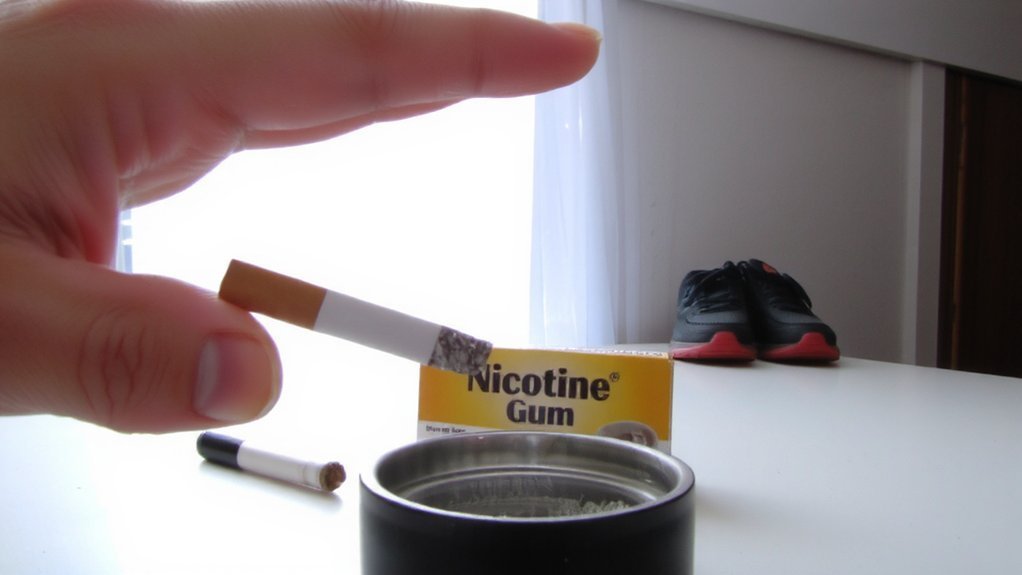You can quit smoking for good, but it takes a clear plan and realistic support. Nicotine rewires your brain, so you’ll face cravings, withdrawal, and slips. You can quit abruptly or taper, and combining counseling with medication raises your odds. Keep going—I’ll show the practical steps and choices that actually work…
Why Quitting Is Hard but Possible

Even though nicotine rewires your brain and habits, you can quit—because those changes can be reversed and you can learn new routines.
You’ll face cravings, mood shifts, sleep changes and moments when old cues trigger reflexive reaching.
Withdrawal is temporary; intensity peaks then fades as receptors recalibrate.
Your environment and social patterns keep smoking alive, so you’ll need to identify triggers and plan alternatives.
Stress, boredom and rituals amplify urges, but small consistent actions weaken those pathways.
Use support, healthy substitutes, activity and clear goals to stabilize progress.
Celebrate milestones, expect setbacks without shame, and adjust strategies.
Over time your brain rewards new behaviors, your cravings shrink, and you reclaim control.
Stay patient, keep practicing, and trust the gradual, sustainable improvement ahead every day.
Choosing the Right Method: Abrupt Vs Gradual

Although quitting cold turkey works for some, other smokers do better tapering off—both methods can succeed, but they suit different needs.
You should assess your smoking patterns, triggers, and past attempts to pick a method.
If you have strong willpower and prefer a decisive break, abrupt quitting gives a clear start and removes daily decisions.
If you rely on routines or fear severe withdrawal, gradual reduction lets you cut cigarettes, delay times, and set small goals.
You can combine approaches: a planned taper leading to a quit date or abrupt quitting after a short reduction period.
Track progress, stay flexible, and adjust if cravings or slip-ups occur.
Choose what you’ll commit to and prepare practical coping plans.
Reassess and change course when needed immediately.
Most Effective Treatments: Counseling + Medication

Whether you quit abruptly or taper off, combining behavioral counseling with medication gives you the best odds of staying smoke-free.
You’ll work with a counselor to build skills: identifying triggers, rehearsing coping strategies, planning rewards, and creating relapse plans.
Counseling can be one-on-one, group-based, or delivered by phone or apps, and regular sessions boost your chances.
Medication reduces withdrawal and lets you practice new habits without intense cravings. Together they let you replace automatic smoking with intentional actions.
Talk with your clinician to tailor treatment length, monitor progress, and adjust strategies if cravings return. Stay engaged, keep appointments, and use counseling homework between sessions. If you slip, treat it as feedback and revise your plan; don’t give up.
You deserve long-term freedom from smoking.
Medications Explained: NRT, Varenicline, Bupropion

How do these medications help you stop?
Nicotine replacement therapy (NRT) eases cravings and withdrawal by giving controlled nicotine without smoke; you can use patches, gum, lozenges, inhalers, or nasal spray and taper dose.
Varenicline (Champix/Chantix) reduces cravings and makes smoking less rewarding by blocking nicotine receptors; you’ll usually take it for 12 weeks and may extend.
Bupropion (Zyban) is an antidepressant that lowers withdrawal symptoms and reduces urge; it’s helpful if you’ve had mood concerns.
All three work best combined with behavioral support.
Tell your clinician about medical history, pregnancy, or medications to avoid interactions.
Expect side effects; if they’re intolerable, your clinician can adjust treatment or switch options.
Follow dosing instructions closely and attend follow-up visits to monitor progress and safety regularly.
Digital Tools and Social Support

Tapping into apps, text programs, online communities, and friends or family gives you real-time tracking, tailored coaching, and encouragement when cravings hit.
Use apps that log cigarettes, triggers, mood, and money saved so you see progress and patterns.
Sign up for text-based support to get timely coping tips and reminders during high-risk moments.
Join forums or social media groups where others share wins, setbacks, and practical strategies; that normalization reduces isolation.
Tell trusted people how they can support you—check-ins, distraction, or removing cigarettes from your space.
Pick digital tools with good privacy policies and evidence-based content.
Combine social support with tools that prompt healthy habits, and you’ll strengthen resolve, handle slips, and sustain long-term change.
Reassess tools periodically to match your evolving needs, too.
Preparing Your Quit Plan and Setting a Quit Date
Before you stop, make a clear quit plan and pick a specific quit date—ideally within the next two weeks—so you have time to prepare without losing momentum.
Decide whether you’ll quit cold turkey, use nicotine replacement or prescription support, or follow a gradual reduction, and note why that suits you.
Remove smoking items from your home, car, and workplace before the date.
Tell friends, family, and coworkers so they can offer encouragement and hold you accountable.
Schedule medical appointments, download helpful apps, and join a support group or hotline.
Plan distractions and healthy routines to replace smoking times, and set short-term milestones and rewards to track progress.
Keep your plan written and visible for reference.
Review and adjust the plan as needed before quitting.
Managing Cravings, Withdrawal, and Preventing Relapse
When cravings hit, remember they usually peak in the first few days and then ease—ride them out with short, concrete actions.
Sip water, chew gum, take deep breaths, or walk for five minutes.
Use nicotine replacement or meds as advised; they cut intensity and help you focus.
Track triggers—stress, alcohol, breaks—and change routines to avoid them.
Sleep, eat protein, and move to reduce withdrawal fatigue and irritability.
Tell friends and co-workers you’re quitting so they can support you and avoid offering cigarettes.
If you slip, don’t quit quitting: analyze what led to it, adjust strategies, and resume immediately.
Reward milestones and remind yourself why you started to protect progress and prevent relapse.
Practice stress-management daily and seek counseling when urges feel intense too.
Conclusion
You can quit for good — nicotine rewires your brain but it heals with time. Pick a clear plan: set a date, remove triggers, and choose abrupt or gradual based on what worked before. Combine behavioral support with medication if needed, use coping strategies for cravings, and get social or digital help. Treat slips as lessons, restart immediately, and celebrate each smoke-free day as progress toward lasting freedom. You’re stronger than your addiction and deserve support.